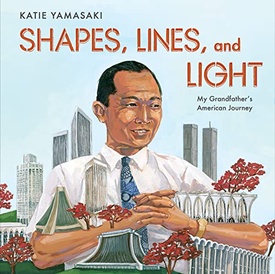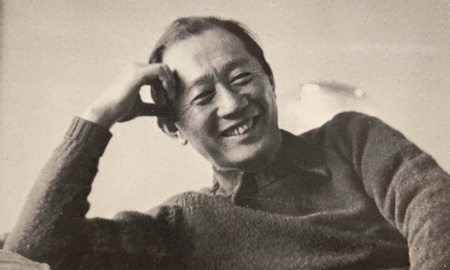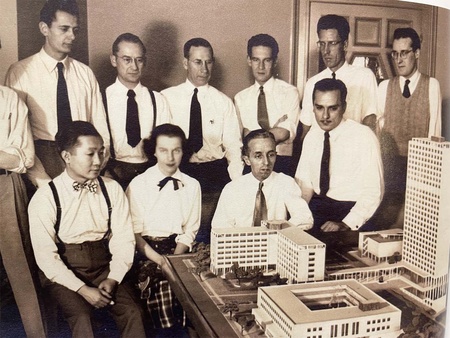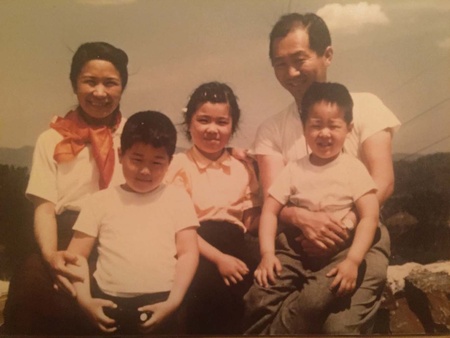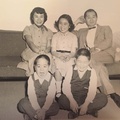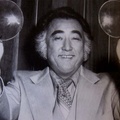Within our families we have stories that we wish to tell the world to encourage others, share the journey of beloved family members, and more. These stories can take a number of different forms, like traditional biographies or even as children’s picture books. Well, recently the author Katie Yamasaki released her new children’s book Shapes, Lines, and Light, which shares the touching story of her grandfather’s life and work.
Shapes, Lines, and Light is a children’s picture book about the life of Minoru Yamasaki, a renowned Japanese-American architect. The book begins with what it was like for Minoru to grow up in the state of Washington as the child of Japanese immigrants, during the early 1900s. From there, the book follows Minoru as he works hard to put himself through architecture school and even what it was like for him to get his first roles as an architect after graduating. This book also discusses the issues Minoru and his family faced during and after World War II.
Shapes, Lines, and Light concludes with a description, both in words and with pictures, of what happened in Minoru’s life in his later years, as well as with some of his well-known architectural designs. Additionally, Katie provides a section at the end of the book for her author notes, where she describes more in-depth some concepts she presented in the book. Katie’s author notes also provide some of her grandfather’s sketches of some of his most well-known, or interesting, building designs.
While the book discusses the life of Katie’s grandfather, it has many themes for readers of any age to enjoy and reflect upon. These themes include hard work being a tool to achieving what you want, how art can be applied in a different way but still be impactful, and how to be more understanding of the world and people around us.
These themes are also carried out and expanded upon in my interview with Katie Yamasaki below, which adds to the richness of her book. All told, Shapes, Lines, and Light is a wonderful read for all and a great conversation starter for children, their family, and teachers a like.
Please enjoy this interview about Shapes, Lines, and Light with author and artist Katie Yamasaki.
* * * * *
Taylor Wilson (TW): What inspired you to write about your grandfather’s story? Was the inspiration in part due to your grandfather’s quote about art/drawing you discuss at the end of your book in the author notes?
Katie Yamasaki (KY): I have wanted to write about our grandfather for a long time. 9/11 was my second day of graduate school at the School of Visual Arts and from that day forward, people have been telling me that I should write his story. But the story I wanted to tell had nothing to do with 9/11. In fact, it had very little to do with the World Trade Center (WTC) in general.
Our grandfather was most known for projects that least represented who he was as an artist and as a person, so I wanted to let time pass after 9/11 to further separate his story from the towers and that tragedy. I wanted to share his story because it is one that is so resonant with so many people, not only from our Japanese-American community, but for anyone who has grown up as an outsider in this country.
He had a miraculous way of transforming his complex life experiences into making spaces where everyday people could feel uplift and peace. I wanted to share the journey that made him interested in the emotional experience of being in a space that was created with the specific intention of making one feel, as he would say, serenity, surprise, and delight.
TW: Why did you feel that you wanted to share your grandfather’s story as a children’s picture book, instead of as a traditional biography?
KY: Children’s books and murals are my mediums, so that was what made the most sense. Wonderful adult books have already been written about him—his own autobiography, as well as recent works by Dale Gyure, Justin Beal, and others, that cover his detailed biography, architectural works, and the social/academic/cultural contexts in which he and his work existed.
My interest was in bringing his story to children, teachers, and parents outside of the architectural world. There are so many ways that children can relate to his story—both what inspired him and what challenged him, and I think that his story is one that can open a young reader’s mind into how challenging circumstances can be transformed into something of one’s own making.
Also, many children have inherent artistic and intellectual interest in architecture and in building spaces, and I hope this will show one unusual version of making that happen as a life’s path.
TW: What do you hope children take away from reading your book? What do you hope parents, or teachers, who read this book with children take away from its story?

KY: Our grandfather grew up at a time when to be Asian in this country, to be Japanese-American, was to be invisible. Or to be seen as less than human. To be seen as undeserving of the promises of this country. He built a life where he would be seen, where he would leave his mark, where he would come to great fame, and become a symbol of success, especially in our Japanese-American community. But it came at a cost.
To work like that, to be driven in a way as to have to prove your humanity comes at a cost and takes a tremendous toll, not just on him, but on his family. And it isn’t fair. Many people in this country, in particular people of color, grow with the belief that we have to be twice as good, work twice as hard, to get half as far. It is impossible to overstate how wrong that is.
What I hope most is that young readers and their grownups will understand from this story is the inherent worth of each one of us. That you don’t have to build the tallest towers, test the highest, run the fastest, win the most. Your life has incredible value for the simple fact of your existence on this earth. That’s what I hope. That’s what I wish someone had told him in the early days of his journey when he was just struggling to be seen.
TW: What do you think your grandfather would want readers to take away from the book?
KY: I can’t say for sure. But what I believe, based on what I’ve heard from the last days of his life, is that what he was thinking about the most at the end of his life was his family. His relationships. And what he sacrificed for his work. I think, I cannot say for sure, but I believe he would encourage young readers to find something meaningful to do with their lives, some way to contribute to improving society for everyone. He would want the young reader to be reminded that in a healthy society, there is no place for (as he called it) “racial hatred” of any kind. And he would encourage the readers of his story to take care of the relationships that mean the most. That’s what I believe he would want.
TW: What was your favorite part of the book to write about? What was your favorite illustration to draw or create?
KY: My favorite part of the book to write about was when he was in the wonderful forests that surrounded the Seattle of his childhood. I loved making that illustration and thinking about the formative relationship he had with the natural world. His life was profoundly complicated, but that he found a place of freedom, joy, and inspiration in the natural world from a young age brings me great joy.
TW: What was the research for the book like for you as Minoru Yamasaki’s granddaughter? Were there elements of his story you already knew before you started the book? Were there things you didn’t know about your grandfather’s story when you started the book? If so, what did you enjoy learning about your grandfather?
KY: It is a challenge to research someone in your family in an unbiased way, but I did my best. My research was a combination of reading the old and new books about him, reading old magazine articles, architectural reviews, and combing through ages of photos of him, his work, and our family. I also did research into the Japanese-American community, especially in Seattle around the time of his early life. That was wonderful for context and I am so grateful to densho.org for the incredible library they have created for all of us.
I also spoke extensively with two writers who had written books about him, Dale Gyure and Justin Beal. That was incredibly helpful because they had both dedicated years of their lives to studying our grandfather and the wisdom they had accumulated about his life and work was profound.
It was also without the lens of personal, lived experience that can color family memories, so it was really helpful to hear stories from various angles. I knew more personal stories than anything else prior to my research. Therefore, my memories and stories of him were more visceral, lived experiences.
One thing that I loved learning about him and his philosophy of his architecture was that the feeling I grew up with, whenever I stepped into any of his buildings, is exactly what he was working to create. This feeling of open air, calm, uplift. It was for everyone.
(*All photos courtesy of the Yamasaki Family)
© 2022 Taylor Wilson


